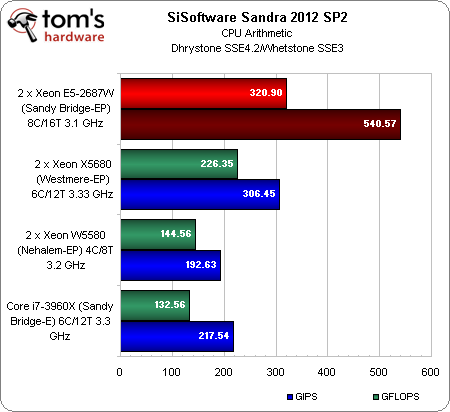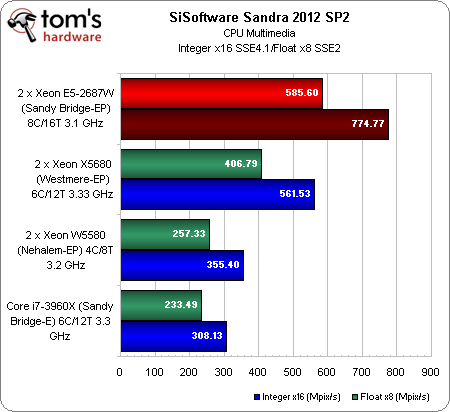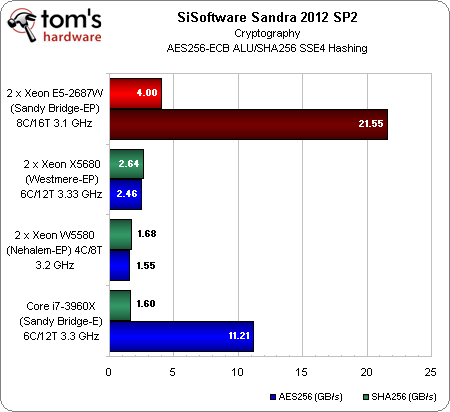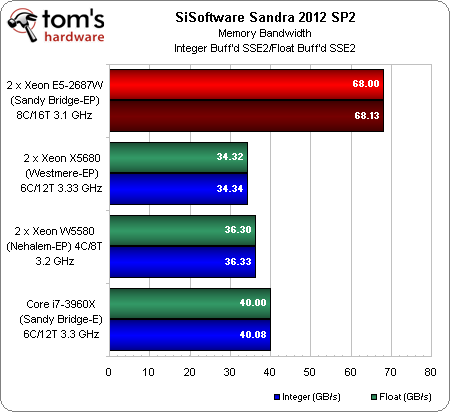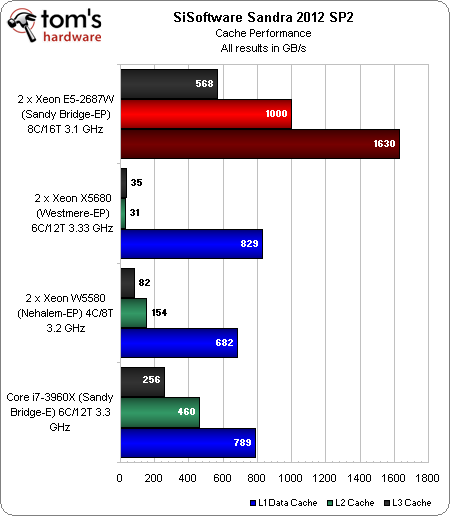Intel Xeon E5-2600: Doing Damage With Two Eight-Core CPUs
Intel's vaunted Sandy Bridge architecture has finally made its way to the company's dual- and quad-socket-capable Xeon processors. We got our hands on a pair of eight-core Xeon E5-2687W CPUs to compare against the older Xeon 5600- and 5500-series chips.
Benchmark Results: Sandra 2012
The theoretical gains moving from two prior-generation Xeon 5600s to a pair of Xeon E5s is impressive, just as the shift from Xeon 5500 to Xeon 5600 was.
A single Core i7-3960X does extremely well compared to a pair of Xeon W5580s. However, the Xeon E5-2687Ws, based on the same Sandy Bridge architecture, benefit from an additional two cores each.
Sandra 2011’s multimedia suite similarly shows the Xeon E5s dominating. We even turned AVX instructions off to make the results more comparable. Applications optimized for the x86 extensions enjoy even greater throughput.
I didn’t bother running standalone AVX numbers this time around because the core architecture we’re dealing with here is identical to the desktop implementation. If you’d like a comparison of Intel’s AVX implementation compared to AMD’s, check out this page in AMD Bulldozer Review: FX-8150 Gets Tested, where Cakewalk’s CTO Noel Borthwick gave us access to AVX-optimized routines from Sonar X1 for testing.
Three of the CPUs in this test should support AES-NI. As I discovered when I wrote Intel Xeon 5600-Series: Can Your PC Use 24 Processors?, the company’s Xeon 5600 engineering samples didn’t yet support the feature, though. As a result, only the Core i7-3960X and Xeon E5s reflect acceleration.
Why the huge performance gap? Well, we have two processors cranking on cryptography versus one, for starters. What might you expect to see from a pair of retail Xeon 5600s in the same test? Lower performance than the E5s, almost certainly. A hardware-based feature like AES-NI is incredibly easy to execute, and we know from tests that I ran in Intel Core i7-3960X Review: Sandy Bridge-E And X79 Express that memory bandwidth is actually the bottleneck in measures of AES256 performance. Thus, a quad-channel memory controller with support for DDR3-1600 has an inherent advantage over a triple-channel controller limited to DDR3-1333.
And here’s a perfect illustration. Although registered DDR3-1600 modules are hard to come by, as mentioned on the previous page, Crucial sent over 64 GB (8 x 8 GB) of PC-12800 memory for our E5-based workstation, enabling close to two times the effective bandwidth on Xeon E5 compared to the Xeon 5600s.
Get Tom's Hardware's best news and in-depth reviews, straight to your inbox.
Interestingly, the Core i7-3960X, armed with unbuffered DDR3-1600 is the second-place finisher, even though its four memory channels are theoretically less capable than a pair of triple-channel Xeons armed with DDR3-1333.
After back and forth emails with Adrian Silasi over SiSoftware, we couldn’t figure out why the cache performance results for the Xeon 5600-series processors were turning out so low (particularly L2 cache bandwidth, which we'd expect to be far higher). One suspicion is that this routine is tripping a throttle due to repeated use of the cache and rapidly-escalating temperatures, though Intel's engineers claim the Xeon 5500s and 5600s don't have this mechanism in place.
It’s clear, however, that the Sandy Bridge-E and Sandy Bridge-EP architectures make big improvements to L3 cache throughput by virtue of their ring buses.
Current page: Benchmark Results: Sandra 2012
Prev Page Test Setup And Benchmarks Next Page Benchmark Results: Adobe Creative Suite CS5.5-
CaedenV My brain cannot comprehend what CS5 would look like with this combined with a 1TB R4 drive, and the GTX680 version of the Quatro would look like... and I am sure my wallet cannot!Reply
Great article! I was not expecting my mind to be blown away today, and it was :) -
dalethepcman No gaming benchmarks? I know this is a high workstation / mid server build, but you know some of the boutiques will make a gaming rig out of any platform. Just out of curiosity, I would have liked to see 2x7970 or 2x580 and a few gaming benchmarks thrown in. :)Reply -
willard dalethepcmanNo gaming benchmarks? I know this is a high workstation / mid server build, but you know some of the boutiques will make a gaming rig out of any platform. Just out of curiosity, I would have liked to see 2x7970 or 2x580 and a few gaming benchmarks thrown in.I'd be really surprised to see these in gaming machines, even in the high end boutiques. That's a $2k processor they reviewed, and basically all it offers over the $1k SB-E chip (for gamers) is an extra pair of cores, which games can't make use of.Reply -
reclusiveorc I wonder how fast TempEncode would chew thru transcoding avi/wmv files to mp3/mp4Reply -
willard esreverwhy aren't AMD cpus tested too? I wouldn't mind seeing how 2x interlagos stacks up.Anandtech benched those next to the new Xeons. Went about as well as Bulldozer vs. Sandy Bridge.Reply
http://www.anandtech.com/show/5553/the-xeon-e52600-dual-sandybridge-for-servers/6 -
cangelini esreverwhy aren't AMD cpus tested too? I wouldn't mind seeing how 2x interlagos stacks up.Mentioned on the test page--I've invited them to send hardware and they haven't moved on it yet.Reply -
willard cangeliniMentioned on the test page--I've invited them to send hardware and they haven't moved on it yet.I would guess that's because Interlagos is garbage compared to the new Xeons and they know it. I don't think they're terribly eager for the front page of Tom's Hardware to show the low end Xeon's beating the best Interlagos has to offer.Reply -
Onus What, or who, was the target? Are there military applications for this weapon?Reply
Sorry, vote me down all you like, but the title was just silly.
